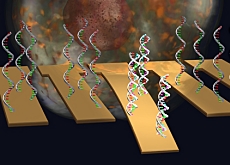Swiss find missing pages in “book of life”

Researchers at Geneva and Lausanne universities have contributed to a massive international project to unravel the mysteries of the human genome.
An in-depth three-year examination of the human DNA “book of life” has turned basic biology concepts upside-down and could rewrite conventional wisdom regarding some causes of disease, according to the scientists.
Three hundred researchers from 80 organisations in 11 countries teamed up to share notes on one per cent of the human genome, our complete biological code.
“The aim is to identify and catalogue all the elements in the human genome,” said Stylianos Antonarakis, head of medical genetics at Geneva University medical school.
Their findings, the start of the Encyclopaedia of DNA Elements or ENCODE Project, were published on Thursday in the journals Nature and Genome Research.
“Our task was to provide an annotation of the genes and to find all the exons [active parts of genes] in the one per cent of the genome that was chosen in the pilot phase,” Alexandre Reymond from Lausanne University told swissinfo.
“One of the main points we found was that for 80 per cent of the genes that we studied, we found new exons,” he said.
In simple English: “Basically, we found that there were many more important pages of the book of life than before.”
Surprise
When the complete human genome was published in 2003, some scientists voiced surprise that humans had only about 30,000 genes – an estimation which has since been reduced to 20,000-25,000 genes, roughly the same number as a sea urchin.
The research has determined however that there is no such thing as “junk DNA”, the portions of the DNA sequence of a chromosome for which, until now, no function had been identified.
About 97 per cent of the human genome has traditionally been designated as “junk”. The remaining “active” three per cent of DNA had been thought to contain the genetic instructions needed to construct other components of cells, such as proteins.
Reymond said the finding came as a surprise because “it goes against everything you find in biology text books. Everything you learn in school and university says you have a gene, then a space, then another gene – what we have found is that everything is interconnected, like a web”.
Benefits
Francis Collins, head of the National Human Genome Research Institute, which funded much of the work, believes the discovery could be useful in understanding and treating disease.
“It would tell you that there is a subtle tweaking of the expression of that particular gene and therefore that particular protein in a person at high risk,” he said, explaining that such people would as a result make too much of the protein or not enough and that drugs might easily be designed to compensate.
Reymond also points out potential benefits of the research.
“Let’s say you are a patient with a monogenetic disease [caused by the mutation of a single gene, such as cystic fibrosis] and you want to find the gene. You find the gene and look for the mutation but you can’t find it.”
This, he says, could be because scientists didn’t know where to look. “Maybe you were looking at the exon that we knew about before – now we also have to look at the exons which we have discovered.”
The Swiss researchers, who have been involved in the project since it began, also hope to contribute to the next phase – studying the remaining 99 per cent of the human genome. They have applied to carry on research and will hear if they have been successful in September.
swissinfo, Thomas Stephens
An organism’s genome is a complete DNA (deoxyribonucleic acid) sequence of one set of chromosomes.
Humans have 23 pairs of chromosomes which comprise around three billion base pairs of nucleotides arranged in a double helix.
Genes are segments of DNA which carry information for making the amino acids and consequently proteins required by all organisms.
Genes interact with each other and the environment to determine an organism’s genotype – its physical development and traits.
Humans are estimated to have 20,000-25,000 genes.

In compliance with the JTI standards
More: SWI swissinfo.ch certified by the Journalism Trust Initiative












You can find an overview of ongoing debates with our journalists here . Please join us!
If you want to start a conversation about a topic raised in this article or want to report factual errors, email us at english@swissinfo.ch.